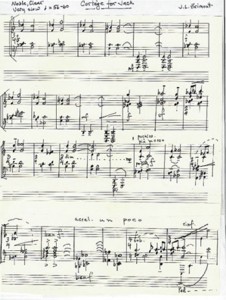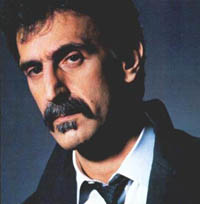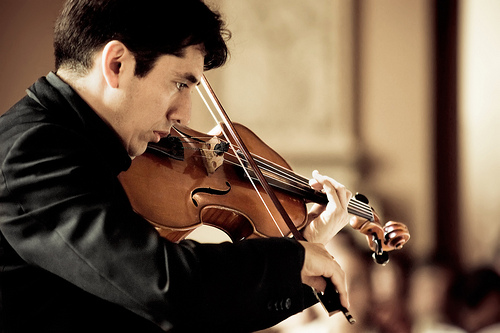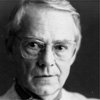Robert Dick in Recital
Institute and Festival of Contemporary Performance
Mannes College of Music (New School University)
June 17, 2010

Robert Dick was a name we heard in graduate school, spoken by flutists and composers alike in hushed, almost reverent tones. His treatise on contemporary playing techniques, The Other Flute, has long commanded a hefty price at various online bookstores (which is somewhat puzzling, as the tome has remained more or less continuously available). I finally found one for less than a king’s ransom a few weeks ago: just in time to ‘study up’ before finally hearing Dick live in recital.
The opener was Luciano Berio’s Sequenza for flute. It’s a little scary to hear Dick’s rendition of this piece – he makes a fantastic virtuosic workout sound like a walk in the park. That said, his rendition of the Berio was not only technically assured, but thoughtful and musically detailed as well. Before performing Shulamit Ran’s East Wind, Dick mentioned how it had been initially difficult to secure the commission; the composer initially balked at what she viewed as a limited palette. But one heard no hesitation in the end product, a soaring, microtone-inflected essay. The Ran piece was, in its own way, every bit as technically demanding as the Berio, but exuded a passionate linear narrative that was most compelling.
Toru Takemitsu’s Itinerant was equally emotive. This time the solo flute is used as an instrument of elegy; the piece was written while Takemitsu was mourning the then recent death of artist Isamu Noguchi. While there are aspects of the piece that are evocative of the shakuhachi, one never feels like Itinerant is merely a transcription. Rather, it transports the flute into an appealingly hybridized manifestation.
Robert Morris’ Raudra is a musical sketch of the rasa (sentiment) of anger from Indian literature. It indulges the flutist’s ‘inner child’ in tantrum mode, angrily riffing up and down the entire instrument’s compass. Morris’ interest in Indian music has found a fascinating outlet here; Raudra combines an awareness of ethnomusicology with a vibrant depiction of fury!
The second half of the program was comprised entirely of compositions by Dick. According to Dick, Afterlight is the first flute piece he’s aware of where multiphonics are a structural determinant of the composition, rather than merely serving as an embellishment or special effect. Whether or not it is actually the first piece to do so, its certainly one of the best – a beguiling etude filled with one shimmering vertical after another. I very much want to get my mitts on the score and recording of this one!
Dick’s a Metallica fan (Who knew?!?). On Air is the Heaviest Metal, he reinterprets thunderous riffs and chugging rhythms for his own instrument. While its not an experiment I would’ve thought likely to work, it brought out an intriguing facet of the flutist’s playing – an abiding interest in popular music – that proved a palette-cleansing corollary to all of the avant-flute pieces surrounding it.
The last two works on the concert were for alternate members of the flute family. Heat History is written for a flute equipped with glissando head joint. “Its kind of like a whammy bar for the flute,” quipped Dick. But the sounds elicited from the instrument thus equipped weren’t just glissandi ‘on steroids.’ Dick also took advantage of many timbral shifts that can occur as a result of the moving head joint, eliciting haunting multiphonics and chirruping microtones as well as the big bends. The title of the work came from an idea suggested to Dick by his father – that objects that undergo chemical makeup changes when subjected to high temperatures have a ‘heat history.’ This made the work’s many kettle whistles and rasps resonate in both musical and programmatic fashion.
Fumarole was inspired by deep sea, sulphur breathing creatures: another evocative image for a title. It was performed on the contrabass flute, which sounds two octaves below a regular flute. Key clicks almost take on the weight of drum thwacks. Sustained notes are potent and weighty. It is an instrument that has to be seen – and heard – to be believed (we’ve included a YouTube clip from 2009 below). Fumarole was a mind-blowing conclusion to an outstanding evening of extended techniques. Anyone who thinks that ‘special effects’ can’t be used in a purposeful fashion to create well-integrated compositions needs to hear Robert Dick in recital.
IFCP is in session this week and next, with events at Mannes and at Le Poisson Rouge. See the festival’s website for more details.




 DM: A long time ago I heard Malcolm play a solo violin improvisation at Carnegie Hall. I was floored by the sounds he got out of the instrument and the way he built a flowing piece on the spot out of all these extended techniques. I later found a string quartet by him, which we performed in 2008, I think. We loved the piece and, I’m happy to say, he was pleased with the performance. We got to talking about having him write a piece for Locrian and “The Sky…” is the result of that. The commission came through the Canada Council. (Malcolm lives in Montreal.) The piece, like most of his works, is a set of coordinated improvisations.
DM: A long time ago I heard Malcolm play a solo violin improvisation at Carnegie Hall. I was floored by the sounds he got out of the instrument and the way he built a flowing piece on the spot out of all these extended techniques. I later found a string quartet by him, which we performed in 2008, I think. We loved the piece and, I’m happy to say, he was pleased with the performance. We got to talking about having him write a piece for Locrian and “The Sky…” is the result of that. The commission came through the Canada Council. (Malcolm lives in Montreal.) The piece, like most of his works, is a set of coordinated improvisations.
 American composer
American composer